Trip Introduction: Everest Base Camp Trekking for Seniors 2025/2026
One of the most famous and well-known hikes in the world is to Everest Base Camp. This trek, which is located in the gorgeous Himalayas, provides an unforgettable chance to see the breathtaking majesty of the Everest Region and stand at the base of Mount Everest, the highest peak in the world. Although the walk has its difficulties, it is a journey that can be completed by the elderly. There are actually a number of strong reasons for senior individuals to think about undertaking the Everest Trek.
The final objective of this package is to enjoy the journey and the experience, rather than just get there. Spend some time appreciating the beauty of the area, enjoying your interactions with the people there, and creating lifelong memories. Your trekking experience can be greatly enhanced by knowledgeable guides and porters. Our guides and porters can help you get around the path, carry your gear, and offer helpful assistance all the way through.
Where does the Everest Base Camp Trekking for Seniors Begin and end?
The trip starts in Kathmandu. From Kathmandu, we take a flight towards Lukla and go to get our permits. From there, we check in and leave for Phakding via Thado Koshi. From there, we pass the beautiful towns of Monjo and Jorsale towards Namche. After reaching and having a rest at Namche, we go for a hike the next day and go towards Tengboche after Namche; from Tengboche, we go to Dingboche via Pangboche and Somare; after that, a rest day; and then going towards Thukla the next day, then reaching Lobuche and going to Gorakshep, checking in at the hotel; then towards Everest Base Camp, back to Gorakshep. The next day, go from Gorakshep to Pheriche and the Phortse village, and then from there to Namche, then back to Monjo, then Lukla, and fly back to Kathmandu.
Everest Base Camp Trek For Seniors Altitude and Distance Coverage
Day | Activity | Altitude (m/ft) | Distance (km/miles) | Duration | Altitude Gain (m/ft) | Altitude Drop (m/ft) |
1 | Arrival in Kathmandu | 1,350 m / 4,429 ft | - | - | - | - |
2 | Sightseeing in Kathmandu | 1,350 m / 4,429 ft | - | - | - | - |
3 | Flight to Lukla & trek to Phakding | 2,860 m / 9,383 ft 2,610m/8,563ft | 9 km / 5.6 miles | 3-4 hrs | +250 m / 820 ft | -500 m / 1,640 ft |
4 | Trek from Phakding to Jorsale | 2,740 m / 8,990 ft | 5.9 km / 3.7 miles | 2-3 hrs | +130 m / 427 ft | -170 m / 557 ft |
5 | Trek from Jorsale to Namche Bazaar | 3,440 m / 11,286 ft | 6.1 km / 3.8 miles | 2-3 hrs | +700 m / 2,296 ft | -0 m / 0 ft |
6 | Rest day at Namche Bazaar | 3,440 m / 11,286 ft | - | - | - | - |
7 | Trek to Tengboche | 3,860 m / 12,664 ft | 10 km / 6.2 miles | 4-5 hrs | +420 m / 1,378 ft | -0 m / 0 ft |
8 | Trek from Tengboche to Pangboche | 3,900 m / 12,795 ft | 3.1 km / 1.9 miles | 2-3 hrs | +40 m / 131 ft | -0 m / 0 ft |
9 | Trek from Pangboche to Dingboche | 4,410 m / 14,468 ft | 5.9 km / 3.7 miles | 3-4 hrs | +510 m / 1,673 ft | -0 m / 0 ft |
10 | Acclimatization day at Dingboche | 4,410 m / 14,468 ft | - | - | - | - |
11 | Trek from Dingboche to Thukla | 4,620 m / 15,157 ft | 5.0 km / 3.1 miles | 2-3 hrs | +210 m / 689 ft | -0 m / 0 ft |
12 | Trek from Thukla to Lobuche | 4,940 m / 16,210 ft | 5.6 km / 3.5 miles | 2-3 hrs | +320 m / 1,050 ft | -0 m / 0 ft |
13 | Trek to Gorak Shep & Everest Base Camp | 5,364 m / 17,598 ft | 15 km / 9.3 miles | 5-6 hrs | +424 m / 1,391 ft | -0 m / 0 ft |
14 | Trek to Kala Patthar & Pheriche | 5,545 m / 18,192 ft | 13 km / 8.1 miles | 7-9 hrs | +181 m / 594 ft | -1,265 m / 4,150 ft |
15 | Trek from Pheriche to Phortse Village | 3,840 m / 12,599 ft | 12 km / 7.5 miles | 5-6 hrs | +0 m / 0 ft | -440 m / 1,444 ft |
16 | Trek from Phortse to Khumjung | 3,790 m / 12,434 ft | 13 km / 8.1 miles | 5-6 hrs | +100 m / 328 ft | -150 m / 492 ft |
17 | Trek from Khumjung to Monjo | 2,835 m / 9,301 ft | 11.7 km / 7.3 miles | 4-5 hrs | +0 m / 0 ft | -955 m / 3,133 ft |
18 | Trek from Monjo to Lukla | 2,860 m / 9,383 ft | ~8 km / 5 miles | 4 hrs | +25 m / 82 ft | -0 m / 0 ft |
19 | Flight back from Lukla to Kathmandu | 1,350 m / 4,429 ft | - | - | - | - |
20 | International Departure | - | - | - | - | - |
What is the Best Season for going on a trip to Everest Base Camp?
Trekking Planner Nepal advises elders and senior citizens to start the trek at the beginning of September or March or at the end of November and May when the trek and trail is less crowded.
The best seasons for senior citizens and elders to trek to Everest are in the spring (March to May) and autumn (September to November). Here's why:
The best time to hike to Everest is during Spring (March to May) when the weather is mild and the sights are clear. Lower elevations see relatively mild daytime temperatures. Generally, bright skies allow for exceptional visibility and breathtaking vistas of the Himalayan peaks. The trees that line the trail are in full bloom, giving the surroundings brilliant colors. In comparison to the fall season, there are also fewer people on the trails.
Autumn is particularly one of the best ideal seasons. At lower elevations and during the day, the temperatures are cool and pleasant. Typically, clear skies allow for stunning, all-encompassing vistas of the Alps. The chance of flight cancellations and trip delays is also lower during the autumn because of the calm weather and low rainfall. The trails may be a little busier than in the spring, but they are still manageable.
The benefits of each season Spring and Autumn must be considered before choosing one over the other. The trekking paths can still be physically demanding, especially at higher altitudes, even though these seasons offer good weather conditions. No matter what season you choose, proper acclimatization, physical fitness, and wisdom are important.
Note - It is essential to speak with the staff of Trekking Planner Nepal to choose the best time of year depending on your unique needs and preferences. Because the mountains may be unpredictable, keep up with the weather forecast and be ready for rapid changes in the weather.
Weather and Climate During the Everest Base Camp Trekking Trail
Due to the varying altitudes along the trail, trekkers will experience a variety of meteorological and climatic conditions during the trek. Here is a summary of what the weather and climate will be like at different places throughout the trek:
- Lower Elevations: The trek begins with a flight from Kathmandu to Lukla, where the climate is often pleasant and similar to that of Kathmandu. A range of 10°C to 18°C is to be expected during the day. At times, the mornings and nights can be a little bit chilly. Days in this area can be partly promising, partly cloudy, or occasionally rainy.
- Mid-elevations (Namche Bazaar to Tengboche): The environment gradually begins to cool as you climb towards Namche Bazaar. The daytime temperature ranges from 0 to 12 degrees Celsius. Temperatures at night can dip from about -5°C to 5°C causing them to be frigid. During this phase, it is frequently cloudy during the day, usually after 2 p.m.
- Higher Elevations (Dingboche, Lobuche, and Gorakshep): The temperature drops as you ascend to higher altitudes. Daytime highs are between 0°C and 12°C. Nighttime lows can be as low as -10°C to -20°C (14°F to -4°F), well below freezing. To stay warm, it's crucial to layer your clothing. With frequent snowfall and strong gusts, the weather in this region can be unpredictable. Visibility may be limited by cloud cover, although clear and sunny days are still possible.
- Everest Base Camp (17,598 feet/5,364 meters): Compared to lower elevations, the base camp, Lobuche and Gorakshep often experience colder and more erratic weather. The temperature can drop below freezing at night, with daytime highs of 0°C to 8°C. In this area, winds might be harsher, and snowfall can happen at any time of year. When you get to your base camp, you must be ready for cold and severe weather.
As a result, Trekking Planner Nepal advises to verify weather forecasts, speak with guides or local authorities, and be aware that weather conditions in the Everest Region might change at any time. Pack proper clothing and equipment to guarantee comfort and safety during the walk, and be ready for unexpected weather changes.

Is Visiting Everest Base Camp a Wise Decision for Elderly People?
Nepal trekking planner stays honest with their clients and we want our clients to say their general health conditions, degree of fitness, and medical histories and conditions to us before the trek.
Consider these points seriously before trekking
- Physical Fitness: The physical demands of the trek to Everest Base Camp is strength, stamina, and endurance. Before starting the walk, senior citizens should evaluate their level of fitness and speak with a medical expert. Physical fitness can be improved through regular exercise and preparation, which will raise the likelihood that the trek will be completed successfully.
- Age and Health Conditions: As many seniors and elder adults have successfully completed the trip, age should not be an issue. It is vital to take into account any underlying medical issues and how they can affect a trek at high altitude. Additional caution or a doctor's approval may be necessary if you have health conditions like heart disease, lung problems, or mobility issues.
- Experience and Preparation: For the physical demands of the trip, senior adults must have a maintained and acceptable level of fitness. Regular activity, such as cardiovascular workouts and trekking practice, can help the body become ready for the difficulties of the walk.
- Support and Guidance: Knowledgeable guides and porters are strongly advised, especially for elderly people and senior citizens. They can carry gear, travel the terrain, and offer crucial support during the adventure. Trekking Planner Nepal frequently provides extra services and knowledge that are suited to their needs.
- Personal Motivation and Expectations: Senior citizens should be able to clear their reasons for making the journey and stay flexible. Realistic expectations must be kept, being ready for the mental and physical obstacles is required, and being open to changing the pace and itinerary as necessary is crucial.
In the end, a senior citizen's and elderly decision to attempt the Everest Base Camp journey should be based on a thorough evaluation of their own health, their degree of fitness, and advice from medical professionals. Safety, physical comfort, and enjoyment of the journey must come first. In the Everest Region, some elderly people might discover other trekking routes or less challenging activities that suit their interests and skills better.
How Difficult is the Everest Base Camp Trek for Seniors, and How to Prepare?
Let’s see the honest answer given by Trekking Planner Nepal to elders
Even for those in good physical shape, the trek of Everest is regarded as difficult. Seniors and elders may face greater difficulties because of things like advanced age, diminished stamina, and significant medical issues. However, many seniors have completed the walk safely with the right planning and safety measures. Here is a summary of how challenging it is and some advice for getting ready:
The Everest trek is rated as moderately challenging. It involves a 20-day trek that covers more than 130 kilometers (80 miles) round trip. The trekking trail features rocky terrain, high ascents and descents, and various weather patterns. The Kala Patthar viewpoint, which is located at an elevation of 5,545 meters (18,192 feet), is the highest point that can be reached throughout the walk during the trek. High altitude, physical stamina, and acclimatization are the key difficulties.
- Physical Preparation: To develop strength, endurance, and cardiovascular fitness, begin with a regular exercise regimen. Concentrate on stair climbing, walking, hiking, and riding. To prepare for the rigors of the trek, gradually increase the intensity and duration of your workouts. Before beginning any new workout program, it is advisable to speak with a healthcare provider, especially if you have any pre-existing medical concerns.
- Trekking Practice: Incorporate longer walks or hikes on rough terrain to especially prepare for hiking. Your muscles and joints will benefit from this preparation for the strenuous nature of the walk. If you can, schedule shorter practice hikes or treks in your neighborhood to mimic trekking conditions and assess your stamina.
- Mental Preparation: It takes courage and determination to trek to Everest Base Camp. Mentally prepare yourself for the intense physical demands, extended walking periods, and potential discomfort. Be optimistic, have reasonable expectations, and enjoy the journey.
- Gear and Equipment: Invest in quality hiking equipment, such as trekking boots that are supportive and comfortable, layers of clothes that wick away moisture, a quality sleeping bag, a backpack, and trekking poles for increased stability. Before the walk, give your equipment some time to break in and be comfortable.
- Hydration and Nutrition: Drink a lot of water to stay hydrated the entire walk. Having enough nutrition is crucial for keeping your energy levels high. Make sure your diet is well-balanced, including a variety of carbs, proteins, and healthy fats. Utilize the meals offered by the regional lodges and teahouses along the walking path.
Consult with the experts from Nepal Trekking Planner, who specialize in setting up treks for senior citizens. They can make helpful recommendations, modify the itinerary to suit your needs, and provide support throughout the vacation. Keep in mind to pace yourself, pay attention to your body, and put your health and safety first. It's crucial to communicate and be honest with your guide if you ever feel ill or start to show signs of altitude sickness throughout the journey. You should also ask him for medical treatment if necessary.
Is Trekking Towards Everest Base Camp Safe for Seniors?
Seniors can safely trek to the base camp of Everest with the right planning, safety measures, and consideration of their own health and fitness levels. It's essential to recognize that high-altitude walking carries some inherent risks, though. Here are some things to think about when it comes to senior safety:
- Physical Health and Fitness: Senior trekkers should get a complete physical examination and speak with their doctor before starting the journey. Make sure you are in good physical condition for the walk and address any existing medical issues. It's critical to be informed of any restrictions or particular safety measures required for your health.
- Trekking Experience and Support: Senior trekkers should hire a knowledgeable guide or sign up with a trustworthy trekking organization. They can offer encouragement, direction, and invaluable information about the trip, the weather, and safety measures. Experienced porters and guides can help with carrying gear and negotiating difficult trail parts.
- Weather and Environmental Conditions: Weather in the Everest Region can be unpredictable and include snowfall, strong winds, and abrupt temperature fluctuations. Keep up with weather forecasts and be ready for a range of circumstances. Wearing layers and having the right equipment will help you stay warm and protected from wind, rain, and cold.
- Hydration and Nutrition: During the journey, sustaining energy levels and general well-being requires proper hydration and nourishment. Drink plenty of water to stay hydrated, and fuel your body with healthy meals to keep it going during the entire journey.
- Communication and Emergency Plans: Make sure you have a strong method of communication to stay in touch with your trekking team or guide, such as a cell phone or satellite gadget. Know how to evacuate in case of an emergency, and have travel insurance that includes evacuation in case of medical issues.
- Personal Limits and Decision-Making: Senior trekkers must pay close attention to their bodies, understand their own limitations, and let the trekking team know if they feel any discomfort or other issues. Make decisions based on your well-being without hesitation, even if it necessitates changing the plan of action or going to a lower elevation.
Seniors can safely reach the Base Camp, but it's crucial to proceed with caution, make the necessary preparations, and make an honest assessment of their personal capabilities. Many senior citizens have successfully finished the trek and had a special experience in the Everest Region with the correct preparation, encouragement, and adherence to safety precautions.
How do Seniors Cope with the Altitude during the Everest Trek?
Seniors can take certain measures to handle the altitude of the Everest region. Here are some tips to help them acclimatize and minimize the effects of high altitude:
- Gradual Ascent: By selecting a schedule that includes rest days and gradual ascents, you will give your body ample time to get used to the higher elevations. This lessens the likelihood of altitude sickness while also assisting your body in adjusting to the lower oxygen levels.
- Stay Hydrated: To stay hydrated, consume plenty of liquids, ideally water. Hydration is important for acclimatization since it lessens the effects of altitude sickness. Avoid drinking too much alcohol and coffee because they can cause dehydration.
- Pace Yourself: Trekking should be done slowly and steadily. Maintain a pace that is easy to breathe at and is sustainable so as to prevent overexertion. It's crucial to listen to your body and keep in mind that this is not a race.
- Proper Nutrition: To fuel your body for the trek, eat a balanced meal that includes enough carbohydrates, proteins, and healthy fats. Your general health and energy levels are supported by a balanced diet, which can aid in altitude adaptation.
Before the journey, speak with your healthcare professional to go through any prescription drugs or dietary supplements you might need to avoid getting altitude sickness. a frequently given drug that can help prevent and treat altitude sickness symptoms.
- Medication and Supplements: Pay close attention to any altitude sickness symptoms or indicators, such as headache, nausea, dizziness, exhaustion, or appetite loss. Be honest about your feelings with your trekking crew and guide. Be ready to change your plans, take off days, or descend to lower elevations if required to give your body time to relax.
- Listen to Your Body: In order to protect yourself from the chilly weather at higher altitudes, layer your clothing and dress appropriately. Your body can preserve energy and deal with the effects of altitude stress better if you keep your body temperature at a comfortable level.
- Keep Calm: Throughout the walk, maintain a positive outlook and mental health. Maintain your calm, take in the scenery, and control any worry or anxiety. Use meditation or deep breathing exercises to promote relaxation and oxygenation.
- Positive Mindset and Mental Well-Being: Keep in mind that, regardless of age, everyone reacts to altitude differently. It's critical to be mindful of your body and modify your hiking plans as necessary. Be open-minded, pay attention to the guidance of knowledgeable guides, and put your health and well-being first while on the hike.
Being Senior and Elder-aged, are there some things to Consider Before Traveling to Everest?
Absolutely. There are several important considerations for senior and elder individuals before trekking to Everest Base Camp. Here are some key factors to keep in mind:
- Health Check-up: It's imperative to get a thorough health check-up before starting any physically strenuous expedition. Consult your doctor to determine your degree of fitness for such an excursion, discuss any existing medical concerns with them, and review your general health. Obtain medical approval if required.
- Fitness and Training: Exercise regularly in the weeks before the hike. Concentrate on exercises that increase your flexibility, strength, and cardiovascular endurance. Include walking or hiking on difficult terrain to replicate the conditions encountered when trekking. To boost your stamina, start out slowly and gradually increase the length and intensity of your workouts.
- Altitude and Acclimatization: Understand the potential challenges of high altitude. Research and educate yourself about the symptoms of altitude sickness, such as headache, nausea, dizziness, or fatigue, and familiarize yourself with proper acclimatization techniques. Choose an itinerary that allows for a gradual ascent and includes rest days for acclimatization.
- Trekking Duration and Pace: Take into account the miles traveled each day and the length of the expedition. Choose a trek route that delivers a manageable pace and provides enough time for rest and recuperation. Seniors may adjust to the challenges of walking better with longer routes and more downtime.
- Packing and Gear: Make sure you have the right attire and equipment for the hike. Invest in good walking boots, cozy layers of clothing that wick away moisture, a warm sleeping bag, and other necessary trekking gear. Pack sensibly, keeping in mind weight restrictions and your own comfort requirements.
- Travel Insurance: Get comprehensive travel insurance that includes evacuation, medical emergencies, and trip interruption or cancellation. Make certain that it expressly mentions trekking activities and high-altitude locations.
- Mental Preparedness: Prepare your mind for the difficulties of the walk. Be optimistic, set reasonable goals, and be flexible enough to change your plans as needed. The ability to maintain mental toughness is crucial to finishing the walk.
Is there any Special kind of Food and Accommodation for Seniors?
We provide senior trekkers and elders good lodging and meal alternatives throughout the trek that are suited to their needs. Although the facilities in the remote mountains may be limited, Trekking Planner Nepal always tries to provide appropriate options. Here are some things to keep in mind when planning food and lodging for seniors and elders before trekking:
- Accommodation: There are tea houses or lodges that offer basic lodging along the trekking path. These are modest inns with plain beds and blankets in either individual or shared rooms. It's best to select lodging with positive evaluations and dependable amenities. The quality and quantity of lodging may vary throughout the trek, with more choices in well-known locales like Namche Bazaar or Lukla.
- Food Options: Trekkers can get food at the tea shops and lodges along the trail. Dishes from Nepali, Indian, Tibetan, and Western cuisines are frequently included on the menus. Seniors with particular dietary needs or limitations should let the lodge owners or guides know ahead of time so they may do their best to meet your needs. There are frequently vegetarian options available, and whenever feasible, fresh products are used.
- Hygiene and Food Safety: Prioritizing cleanliness and food safety is crucial when trekking. Select lodges and tea rooms that adhere to sanitation standards and hygienic food handling procedures. Avoiding raw or undercooked foods, choosing hot, well-cooked meals, and consuming bottled or purified water are all advised. To ensure that the water you drink is safe, carry water purification pills or a water filter.
- Snacks and Energy Bars: You might find it useful to bring along some snacks or energy bars for additional sustenance throughout the hike. When meal options are scarce, these can provide you with a quick energy boost and are practical.
- Special Dietary Considerations: It is advised to bring any necessary medications or additional food items that meet your needs if you have any specific dietary concerns or limits, such as allergies or intolerances. However, it's crucial to be aware of the weight limits for your hiking equipment.
- Altitude and Fluid Intake: It's important to stay hydrated, especially at higher altitudes. To prevent dehydration, consume plenty of fluids, particularly water. Hydration can keep you healthy overall and help you avoid altitude-related ailments.
- Nutritional Considerations: Make sure you eat a balanced meal that includes enough proteins, carbohydrates, and healthy fats to power your body throughout the walk. Maintaining energy levels and promoting general health depend on this.
While the lodging and dining options on the trekking period at mountains may not be lavish, Trekking Planner Nepal typically offer trekkers, even seniors, the nourishment and comfort they require.
Note: It is advisable to inform your guide or Trekking Planner Nepal agency in advance of any special dietary requirements or concerns so they can assist in making the necessary accommodations.
What are the Washing and Toilet Facilities at Everest Base Camp?
The washing and toilet facilities can vary along the trail. Here are some general aspects to consider:
- Washing Facilities: There are tea houses or lodges that offer private or shared restrooms with running water in the lower altitude regions and well-known trekking destinations, such as Lukla, Namche Bazaar, Tengboche, and Dingboche. Western-style basins are popular in these restrooms. However, keep in mind that there might not be as much hot water available as you'd want, and you might have to pay more for hot showers.
- Toilets: The toilet facilities along the trek are generally squat-style toilets. In lower-altitude areas, tea houses or lodges usually have attached or shared bathrooms with flush or pit toilets. However, as you go higher, in shared toilets, the availability of flush toilets may decrease, and you may encounter basic Asian toilets.
- Paying for Toilet Facilities: In some tea houses or lodges, you may be required to pay a small fee to use the toilet facilities. This fee helps cover the costs of maintenance and sanitation in these remote areas.
- Bring Toilet Paper: It's recommended to carry your own toilet paper or tissues, as they are not provided in all toilet facilities and we must buy them separately along the trail.
- Hygiene Considerations: Even though restrooms and washing machines may not be luxury items, maintaining good cleanliness is crucial. When access to water is scarce, carry antiseptic wipes or hand sanitizer to clean your hands. Additionally, it's a good idea to include a small towel or quick-dry travel towel for your own use.
Nepal Trekking Planner advises to prepare for the most basic amenities and to lower your expectations in line with that. You travel through remote Himalayan areas on the Everest Base Camp trip, where the infrastructure might not be up to city standards. While preserving adequate cleanliness and comfort, many trekkers, including elders, have successfully finished the walk despite the limited amenities.
Travel Insurance Before Traveling to Everest Base Camp.
Trekking Planner Nepal strongly advised to have complete travel insurance that addresses the unique requirements and dangers of high-altitude trekking when making the climb to Everest Base Camp. When buying travel insurance for Everest, keep the following factors in mind:
- Emergency Medical Coverage: Make sure that your insurance policy covers emergency medical costs, including prescriptions, hospital stays, and transportation. It should pay for the expenses related to altitude sickness, which may call for a medical facility or an urgent helicopter evacuation to a lower height.
- Evacuation and Repatriation: Verify that your insurance policy covers emergency evacuation and repatriation, which involve bringing you to the closest suitable medical institution or, if necessary, returning to your home country for treatment. In the event of an emergency, a helicopter evacuation may be necessary due to the remoteness and difficult terrain of the Everest region.
- Trip Cancellation or Interruption: Look for insurance that offers protection against travel interruption or cancellation brought on by unforeseeable events like personal difficulties, health problems, or natural catastrophes. This can assist in covering non-refundable costs like airfare, lodging, or permits for hiking.
- Personal Belongings and Baggage: Determine whether loss, theft, or damage to bags and personal items during the trek is covered by your insurance coverage. This can offer reimbursement for the cost of misplaced or broken items like clothing, electronics, or hiking equipment.
- High-Altitude Trekking Coverage: Make sure that high-altitude trekking activities, such as the trip to Everest Base Camp, are expressly covered by your insurance. Verify that your chosen insurance coverage covers elevations above 4,000 meters (13,000 feet) or the exact altitudes encountered during the walk. Some insurance policies may have altitude restrictions.
- Pre-existing Medical Conditions: If you have any pre-existing medical illnesses, be sure to find out if any potential repercussions from such conditions during the hike are covered by your insurance. Pre-existing conditions may not be covered by all insurance, while others may offer either limited coverage or charge higher premiums.
- Policy Duration: Make sure your insurance policy covers the entire trek, as well as any pre- or post-trek activities or side trips you intend to take.
- Read the Policy Terms and Conditions: For information on the coverage limits, exclusions, deductibles, and claim processes, carefully check the insurance terms and conditions. Be aware of any particular prerequisites or supporting evidence required before filing a claim.
Give them particular information about your hike so we can make sure you have adequate coverage for any hazards or difficulties you may face.
Why Should Senior Citizens select Travel Companions for the Everest Base Camp Trek?
As a senior citizen considering the Everest Base Camp Trek, Nepal Trekking Planner can be an excellent choice for several reasons:
- Expertise in Senior Treks: We are the best trekking agency in Nepal when it comes to organizing treks for senior citizens and understand the specific needs and considerations of older trekkers. They can provide personalized guidance and support to ensure a safe and enjoyable trekking experience for seniors.
- Customized Itineraries: We tailor the trekking itinerary to accommodate the pace and physical capabilities of senior trekkers. They can create a trekking plan that includes additional rest days, shorter hiking distances, and adequate acclimatization to help seniors adjust to the altitude and minimize the risk of altitude sickness.
- Experienced Guides: The company employs experienced and knowledgeable trekking guides who are familiar with the trail. These guides can provide valuable assistance, share local insights, ensure your safety, and offer support throughout the trek. They can also help you navigate any challenges that may arise along the way.
- Safety Measures: Our trekking agency prioritizes the safety and well-being of their clients. They have safety protocols in place and adhere to responsible trekking practices. Their guides are trained in first aid and have the necessary knowledge to handle altitude-related issues and other emergencies.
- Personalized Support: The company offers personalized support before, during, and after the trek. They can assist with travel arrangements, permit processing, equipment rental, and any pre-trek preparations. They are responsive to your questions and concerns, ensuring that you feel confident and prepared for the journey.
- Local Expertise and Cultural Immersion: Arranging and providing insights into the local culture, traditions, and natural beauty of the Everest Region. They can facilitate interactions with local communities, allowing you to gain a deeper understanding of the Himalayan way of life.
- Positive Reputation: The company has a positive reputation among past clients and in the trekking community. You can read reviews and testimonials from other senior trekkers who have chosen our service and packages.
Remember to communicate your specific needs, concerns, and fitness level with Nepal Trekking Planner so that they can tailor their services accordingly. It's essential to have open and transparent communication to ensure a successful and enjoyable trekking experience as a senior citizen.
Outline Itinerary For Everest Base Camp Trekking for Seniors
- Day 1: Arrival in Kathmandu and Trip Preparation.
- Day 2: Guided Sightseeing Tour and Trek Preparation day in Kathmandu
- Day 3: Flight to Lukla and trek to Phakding
- Day 4: Trek from Phakding to Jorsale
- Day 5: Trek from Jorsale to Namche bazaar
- Day 6: Hiking and Rest Day at Namche Bazar
- Day 7: Trek to Tengboche
- Day 8: Trek from Tengboche to Pangboche
- Day 9: Pangboche-Dingboche
- Day 10: Hiking and Acclimatization Day.
- Day 11: Dingboche-Thukla.
- Day 12: Thukla-Lobuche
- Day 13: Trek to Gorak Shep and Everest Base Camp
- Day 14: Trek to Kala Patthar and to Pheriche
- Day 15: Pheriche-Phortse village.
- Day 16: Phortse to Khumjung
- Day 17: Khumjung to Monjo
- Day 18: Monjo to Lukla
- Day 19: Flight back from Lukla To KTM
- Day 20: International Departure.




-1.webp)
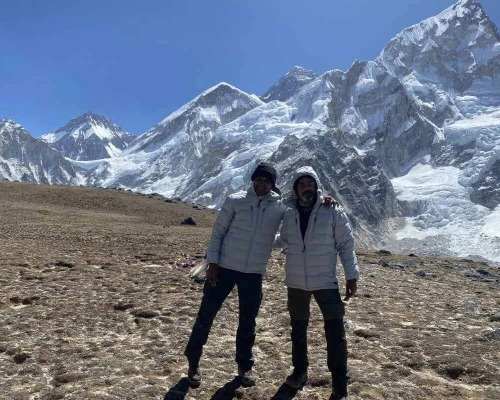
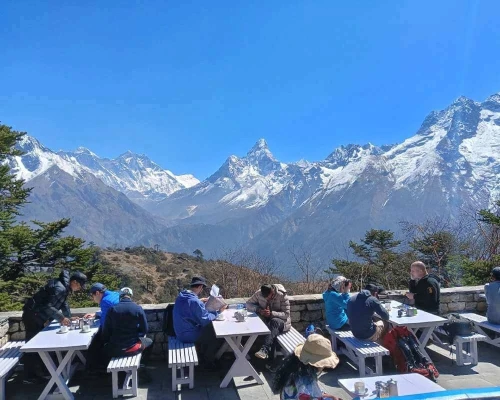
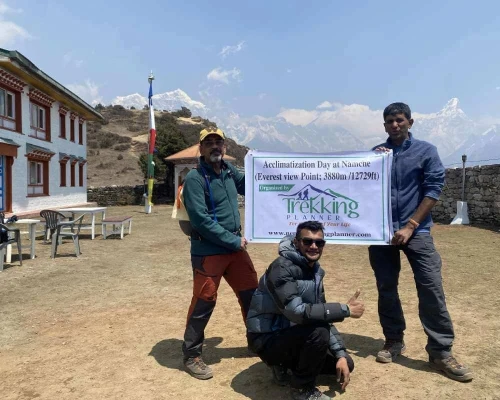

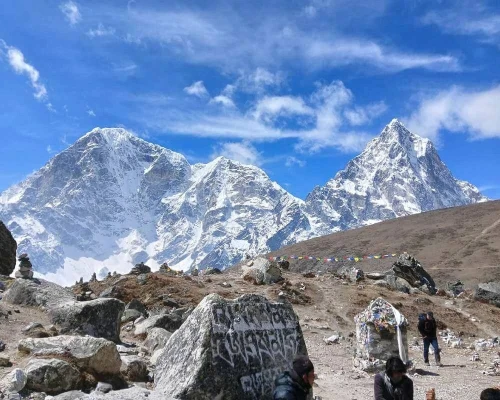
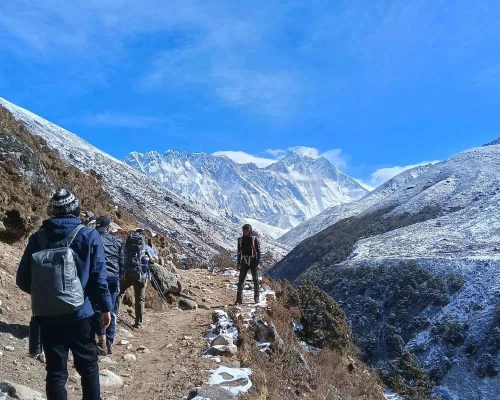

 General
General Upper Body
Upper Body Lower Body
Lower Body Other Essentials
Other Essentials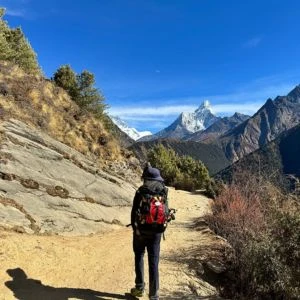
.webp)



